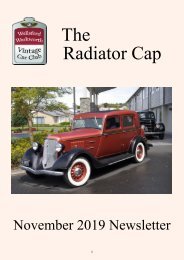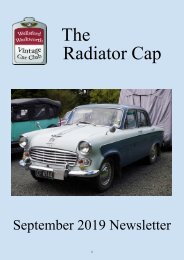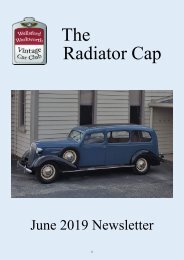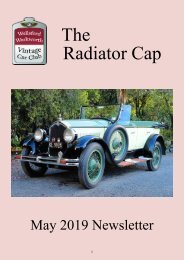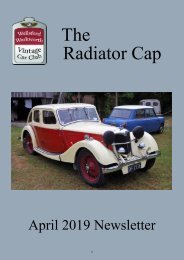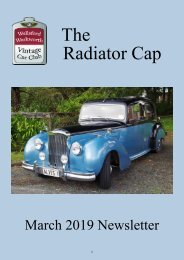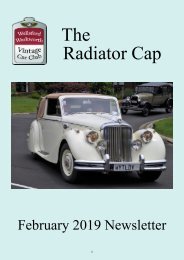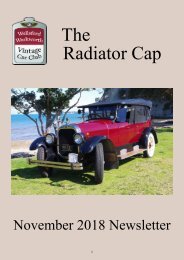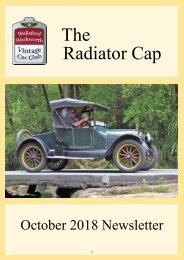Radiator Cap December 2018
Newsletter of the Wellsford-Warkworth Branch of the Vintage Car Club
Newsletter of the Wellsford-Warkworth Branch of the Vintage Car Club
Create successful ePaper yourself
Turn your PDF publications into a flip-book with our unique Google optimized e-Paper software.
The<br />
<strong>Radiator</strong> <strong>Cap</strong><br />
<strong>December</strong> <strong>2018</strong> Newsletter<br />
1
COMMITTEE MEMBERS<br />
Chairman Anne Richardson 09 425 6298 / 021 277 9010<br />
ricanne@gmail.com<br />
Immediate Past Chairman Leon Salt 09 423 8122 / 027 423 8122<br />
brendda@xtra.co.nz<br />
Secretary Peter Yarham 09 422 9685<br />
pyarham@xtra.co.nz<br />
Treasurer Leon Salt 09 423 8122 / 027 423 8122<br />
brendda@xtra.co.nz<br />
Club <strong>Cap</strong>tain<br />
Vacant<br />
Assistants Neil Cremer 09 425 4955<br />
neilmtf@xtra.co.nz<br />
Frances Ross 09 425 8737<br />
John Duffy 021 208 7474<br />
johngduffy38@gmail.com<br />
Newsletter|Website Chris Harvey 09 422 2662 | 022 365 0171<br />
chris.harvey@westnet.com.au<br />
Health & Safety Leon & Brendda Salt 09 423 8122 / 027 423 8122<br />
brendda@xtra.co.nz<br />
Vehicle ID James Lawrie 09 425 9928<br />
gloria-james-lawrie@xtra.co.nz<br />
Motorcycle Rep.<br />
National Executive Delegate Leon Salt 09 423 8122 / 027 423 8122<br />
brendda@xtra.co.nz<br />
National Executive Observer<br />
Librarian Frances Ross 09 425 8737<br />
Property Supervisors George Lloyd 09 425 7622<br />
yorksandlancs@gmail.com<br />
Badges Leon Salt 09 423 8122 / 027 423 8122<br />
brendda@xtra.co.nz<br />
Anne 021 214 2267<br />
Hospitality Convenors<br />
Anne & Dennis<br />
Dennis 021 265 2466<br />
McDonald<br />
annedenmac@gmail.com<br />
Deadline for contributions to the newsletter is 23rd of the month..<br />
The opinions expressed in the newsletter are not necessarily the views of the branch.<br />
Branch address: PO Box 547, Warkworth 0941<br />
Bank a/c: BNZ 02-0480-0047413-000<br />
VERO Agency No. 0300159<br />
VERO Free phone 0800 658 411<br />
wellsfordwarkworth@vcc.org.nz<br />
Visit our website<br />
www.vcc-wellswark.org.nz<br />
2
Sun 2 Dec 11:00 onwards arrive at 108 Wilson Road for the Posh Picnic starting at 12:00<br />
Wed 5 Dec<br />
Sun 16 Dec<br />
Wed 16 Jan<br />
Thu 17 Jan<br />
Sun 20 Jan<br />
Wed 6 Feb<br />
Sat 9 Feb<br />
Thu 14 Feb<br />
12:00 midweek picnic at Snell’s Beach: park in Sunrise Blvd beyond playground<br />
12:00 Christmas lunch at The Salty Dog<br />
12:00 mid-week picnic at Brick Bay<br />
19:00 Club Committee meeting<br />
11:00 meet near Neil Cremer’s house 16 Jackson Crescent for a picnic on Tony<br />
Niccolls’ farm at Martin’s Bay<br />
12:00 mid-week picnic at Scandrett Bay<br />
Display cars at Leigh School Summer Festival<br />
Club Night<br />
16—17 Feb National Motorcycle Rally<br />
Wed 20 Feb<br />
Thu 21 Feb<br />
Sat 23 Feb<br />
Wed 6 Mar<br />
Sat 9 Mar<br />
Thu 14 Mar<br />
Sat 16 Mar<br />
Coffee & Cleaning and Working Bee before the Swapmeet<br />
19:00 Club Committee meeting<br />
Swapmeet<br />
12:00 Midweek picnic<br />
Are we there yet? Rally<br />
Club Night<br />
A & P Show<br />
Christmas Dinner at The Salty Dog<br />
12:00 Sunday 16 <strong>December</strong><br />
$30 per person payable to the Treasurer in cash on the day.<br />
Let Anne & Dennis McDonald know by 10 Dec if you will attend<br />
and /or if you have dietary restraints. Phone 09-422 0041 or<br />
Email annedenmac@gmail.com Bring a $5 Secret Santa gift<br />
wrapped for a male or female.<br />
3
CHAIRMAN’S REPORT<br />
T<br />
his is my last report of this eventful year. I would like to thank those of you who<br />
have given their support and time willingly to help in various ways; at events,<br />
working at our club rooms; also supporting and participating in our activities. May<br />
2019 be even more participative. A special Thank You to Jack Algie who brought along<br />
freshly made scones to cleaning morning.<br />
I had expected to be able to report on successful Santa Parades: four cars made it to<br />
Wellsford and escaped before the rain, but Warkworth was cancelled because of the early<br />
morning conditions and forecast (the sun was out by 11.30! ). Never mind, there is always<br />
next year.<br />
Looking ahead to early 2019, please check the events page for up to date information.<br />
There is an extra Sunday picnic on 20th January, arranged by Neil Cremer. The first big<br />
event of the year is the Swap Meet. Please give Doug Hamilton as much help as you can:<br />
he is leading on the arrangements this time. We will have a Working Bee on cleaning day at<br />
the club rooms before the Swap Meet to tidy up and to sort out any items we are not using<br />
so we can sell them on our stall. If you have anything in the club rooms that you want returned,<br />
please let a committee member know and you will be let in to retrieve it.<br />
I am hoping to be more active on the motoring side next year, with a healthy engine. So,<br />
here’s to a Happy and participative year for the club, Season’s Greetings for Christmas and<br />
a Healthy Safe Motoring year for all club members.<br />
Cheers,<br />
Anne.<br />
4<br />
Wednesday 20 February
CLASSIC CARS & AUTOMATIC TRANSMISSION<br />
TECH TIPS BY IAN CUNNINGHAM<br />
I<br />
n the 1950s Automatic Transmissions started to appear widely as an option and debates<br />
as to the merit of manual versus auto was always interesting. The advantage is<br />
two pedals instead of three and in todays traffic that really is an advantage. However,<br />
manual transmissions use less power to drive the vehicle and that makes them slightly<br />
more economical (more miles per gallon – old school measure—or fewer litres per kilometer).<br />
The early autos were mainly two stage, and as time went on three stage became the norm.<br />
The American companies coined fancy names for them like<br />
Dynaflow introduced by Buick in 1948<br />
Ford-O-Matic introduced in 1951<br />
Power Glide—Chevrolet & Pontiac<br />
Trimatic—GM | Holden<br />
Hydramatic—GM | Cadillac<br />
TorqueFlite– Chrysler<br />
Ford C4 and C6—various models<br />
Delco 350—various models<br />
BorgWarner 65 & the 35 used in many English | European<br />
cars—and the lifeline of the transmission repair shop.<br />
An automatic transmission is an hydraulic drive system needing a low pressure, large volume<br />
of fluid to both drive and lubricate the unit (somewhere around 400 PSI).<br />
The transmission works a little like a centrifugal clutch through a series of gears to drive<br />
the differential, thus driving the wheels.<br />
A fluid coupling (torque convertor) with engine at idle results in no drive. As engine revs<br />
increase the coupling exerts drive to the gearbox in a smooth manner.<br />
The system changes gears through a complex valve chest, locking and unlocking planetary<br />
gears and bands hydraulically. The gearbox will change gears automatically up and down<br />
and is road speed sensitive as to when this happens.<br />
The transmissions used in classic cars are usually 2-speed and 3-speed. These types are<br />
serviceable as they have mechanical | hydraulic operation with no computer control, and<br />
they require servicing from time to time. Most transmissions benefit from keeping the<br />
5
the adjustments up to spec and, as we now spend a lot of time stopping and starting in<br />
traffic, servicing will be advantageous. Keeping the oil level correct is a must as low oil level<br />
can make the transmission slip or overheat . The correct oil must be adhered to as well.<br />
The condition of the oil is an important factor as auto transmission oil has a high degree of<br />
additives and these break down over time. I personally watch for colour, odour and feel in<br />
the oil. Any slight change in in the automatic transmission oil is an indication of a service<br />
requirement (reset bands, change oil etc) The filter in auto transmission systems is not<br />
complex and wont filter out all particles. Tired oil will cause excessive wear on bands and<br />
clutch linings. A well serviced transmission will last a very long time between overhauls.<br />
Transmission Fluid<br />
Transmission fluid allows the transmission to work. Transmission fluid works as a lubricant for the parts<br />
within your transmission. Transmission fluid is optimized for the functions of the transmission. These<br />
functions include valve operation, brake band friction, and the torque converter. Transmission fluid is required<br />
in all automatic transmissions.<br />
Transmission Oil<br />
While all automatic transmission require transmission fluid, this is not true for all manual transmissions.<br />
Some manual transmissions do use transmission fluid, but others use gear oil or sometimes engine oil.<br />
Sometimes gear oil is called transmission oil. The transmission oil lubricates the manual transmissions and<br />
other parts involved.<br />
Transmission oil has a noticeable odour because of its sulfur-bearing anti-wear compounds. These compounds<br />
are necessary to reduce high sliding friction by the helical gear cut of the teeth. In a motorcycle in<br />
which the clutch is bathed in transmission oil, there is usually nothing separating the lower part of the<br />
engine from the transmission, so the same oil lubricates both the engine and transmission.<br />
Transmission Oil Change<br />
The transmission fluid in an automatic transmission will typically need to be changed out every now and<br />
then. The same is usually true for transmission oil in manual transmissions. However, speaking very generally,<br />
transmission oil changes are needed less frequently than transmission fluid changes. Some auto<br />
manufacturers claim that the oil never needs to be changed, as their transmission is a closed circuit. However,<br />
the oil might need changing due to other transmission problems, repairs, or leaks. These claims<br />
should be treated with a critical eye and you should ask a technician at a transmission shop if your specific<br />
vehicle might require a transmission oil change. (See https://www.mistertransmission.com/ )<br />
6
Use this very simple method to test if a setting is out of spec:<br />
With engine at idle (brake applied) shift transmission lever to N.<br />
Shift transmission lever to D, and you should feel Drive engage almost straight away.<br />
Shift trans lever to N and now shift transmission lever to R: you should feel Reverse engage<br />
almost straight away.<br />
Any noticeable difference in delay means that attention is required .<br />
Now we come to what sort of oil we need to use in older transmissions.<br />
The Borg Warner 35 is designed to use ATF type F fluid as do Fords with the C4 automatic<br />
transmission installed. This oil is mineral based and seems to work for me. I have been told<br />
to check around because as modern oils develop this issue has become a minefield. Stick<br />
to the better brands like the ones which<br />
make their living solely out of lubricants.<br />
Hope this has some benefit for you<br />
happy car buffs.<br />
Ian<br />
[Hydramatic 3-speed]<br />
7
CLUB CAR OF THE MONTH<br />
THE TELEPHONE : CUNNINGHAM’S CALIENTE<br />
I<br />
t just goes to show what a difference a phone call can make. Sometime in March<br />
2011 we had a call from our long time friend Murray Toms who is, and always will be,<br />
a car enthusiast. He has a special place for all things made by Chrysler. He had found<br />
on the internet a 1914 Dodge Convertible in Detroit, showing unbelievably low miles,<br />
which prompted him to make contact with the dealer handling the sale. After some time<br />
and lots of negotiations this old gem became Murray’s. In the meantime he wondered if<br />
Eileen and I would join him and his wife Valerie and just drive the car from Detroit to Los<br />
Angeles to ship it home. We said ‘yes’. Don’t you love it when a plan comes together? We<br />
thought that because the car was, after all, unknown to us we should allow some time to<br />
make this journey. We applied for a 3-month visa and set forth on 1st June 2011. Arriving<br />
in Detroit and inspecting the Dodge we concluded that we would be doing quite a lot of<br />
R&M on the old girl. The Dodge was 97 years old and no matter what happened we would<br />
be crossing the Rockies and a couple of deserts with four passengers and we would probably<br />
have some problems. (Photos of the Dodge courtesy of Classic Driver # 57)<br />
What a marvellous excuse that was to look for an American Rock & Roll car for us. I have to<br />
say I was like a kid in a candy store. I went to two big car shows, the first at the Ford Village:<br />
that lasted three days. The second was at the Packard Proving Ground and there<br />
were hundreds of car for sale. There I found a Ford Thunderbird, excellent on top but rusted<br />
out underneath. N.B.G. Along the way I met an older mechanic who offered to show<br />
me a car he had at his home. From that Eileen and I became the proud and lucky owners<br />
8
of a 1967 Mercury Caliente convertible. This car had been in the owner’s family in Texas<br />
and he had purchased it, repainted it, rewired it and overhauled the engine, transmission<br />
and brakes and worked on a complete tidy up of the car (chrome etc) and most of the car<br />
is original.<br />
Actually his name is Raymond E. Bright and he had a collection of six cars at his home in<br />
Washington. Michigan. He told us that at 85 years of age working on them was getting<br />
harder to keep them up to scratch. All the cars were stored in an immaculate garage with<br />
heat pumps and dehumidifiers, and they were all covered. Raymond was appalled that we<br />
were driving across to Los Angeles and said we should have them trailered. He said he<br />
never drove his cars in the rain: they only came out on sunny days and were always trailered<br />
to shows. We consider ourselves lucky to have met Raymond, and of course we assured<br />
him that we would take good care of his Mercury and would keep him informed of<br />
our progress. We have contacted him a couple of time since we have been home and he<br />
was pleased to hear from us.<br />
We believe our car’s mileage is genuine and all the numbers add up. It was built in 1967 in<br />
the Loraine factory as a two-door Mercury Caliente Convertible, with a 298 c.i. V8 (2V).<br />
Consecutive No.48458, original colour white, interior trim dark blue vinyl. Date of manufacture<br />
10 April 1967. Transmission C4 automatic. We think the number of convertible<br />
Calientes produced that year was 1,523. The dealers who handled the sale of the Dodge<br />
(Classic Auto Showplace in Detroit) were wonderful to us: they put us in touch with parts<br />
suppliers, and found us a vintage & classic car mechanic who did work for us that we could<br />
not do ourselves. There are plenty of car parts in Detroit.<br />
We soon had our cars set to go and early on a Saturday morning we headed north and<br />
9
crossed the Mackinac Bridge: 5 miles log and 200 feet above the water. Then headed west<br />
into Wisconsin, through Minnesota, South Dakota, Wyoming, Utah, Arizona and then to<br />
California. Typically we covered about 200-300 miles per day. The Dodge started early in<br />
the morning to beat the heat—up to 110 deg F—and travelled at about 35-40 mph. We<br />
left later and caught up, travelling at 60-70 mph. We kept off the freeways, used black top<br />
roads and kept away from big cities. Found a good place to eat and a motel with good aircon<br />
around 2 pm. Checked the town out. Next day the same as before but always looking<br />
for side trips. This way we went to smaller towns and we met the real people. They all like<br />
old cars so we were treated really well.<br />
We drove our Mercury from Detroit to Los<br />
Angeles without too much trouble. Had the<br />
brake booster replaced, a fuel blockage<br />
(back country petrol station) and a universal<br />
cross failure (all Fords of that era do<br />
that). The Dodge completed the trip as<br />
well. She needed a little R&M from time to<br />
time. Left a drip of oil here and there,<br />
caught altitude sickness in Yellowstone<br />
Park, but she got there.<br />
We arrived at Apple Valley, just 90 miles<br />
from Los Angeles central. We concluded<br />
that we had got this far without even a<br />
scratch and were fearful that in Los Angeles the old car would be out of her depth. Also, I<br />
was not keen to drive in the mad traffic of Los Angeles so we trucked both cars to our<br />
shipping agent and spent a week cruising around California in a rental car before returning<br />
home. Altogether a great adventure that we never expected - all because the phone rang.<br />
(The rain and mud at the 2017 Winter Woollies would have horrified Raymond: Ed.)<br />
10
MYSTERY MOTORS<br />
What car is this? Answer in the next newsletter<br />
November’s car was a Henry J, named after Henry J Kaiser who was chairman of the Kaiser<br />
-Frazer Corp which was heavily involved in building Liberty ships in WWII. Aiming to increase<br />
sales of Kaiser cars, in 1949 the company received a federal government loan to<br />
build an economical car for five passengers costing no more than $1,300 which would<br />
attract "less affluent buyers who could only afford a used car" The attempt became a pioneering<br />
American compact car. and to achieve this the car was built with the fewest possible<br />
components. To save body stamping costs the early cars had only two doors, fixed rear<br />
windows, the bare minimum of internal<br />
appointments, and did not have rear bootlids.<br />
It was little cheaper than rivals from the Big<br />
Three and did not sell well as it was regarded<br />
as cheap and nasty with low trade-in value.<br />
In an attempt to boost sales the car was<br />
marketed, with minimal trim changes, as an<br />
Allstate through Sears Roebuck , but that did<br />
not help and it died unlamented in 1954.<br />
11
“ARE WE THERE YET?” RALLY<br />
9 MARCH 2019<br />
F<br />
or the benefit of all new members who have recently joined this Branch, this<br />
event is an Annual Rally and is held as a memorial to the late Mike Brown. Mike<br />
was a member of our Branch and during his time with us, and built up the little<br />
1901 White Steam Car. If you look towards the kitchen from inside the Clubrooms there is<br />
a photo on the wall, on the left-hand side of the servery.<br />
All Mike had to start the restoration were the remains of the car’s steam engine, which<br />
was resurrected from under a macrocarpa tree somewhere in the Napier region. He was a<br />
very talented engineer, making up virtually all the intricate parts of the car himself – a<br />
most creditable effort. He did get to use his car for a period before becoming ill and<br />
attended several Branch activities. He generously gave many of our Branch members rides<br />
in it! His family has donated a large Steam Gauge as a Trophy – which remains in the<br />
Clubrooms. The “ White” remains in the care of his son in the Taranaki region.<br />
Paul & Debbie Hodder won the Rally in <strong>2018</strong> so are setting the course for 2019.<br />
12
13
Low Pressure<br />
Exterior<br />
Cleaning<br />
• Moss & Lichen<br />
Control<br />
Exterior Insect<br />
Control<br />
Contact us today for a free quote!<br />
Phone: 027 275 0080<br />
09 425 8747 or 09 426 2314<br />
Email: chemwash@rosscoltd.co.nz<br />
14
15
Sales.warkworth@guthriebowron,co.nz Tel 09 425 8187 Fax 09 425 8585<br />
If undelivered return to PO Box 547 Warkworth 0941<br />
ADDRESS<br />
STAMP<br />
16






